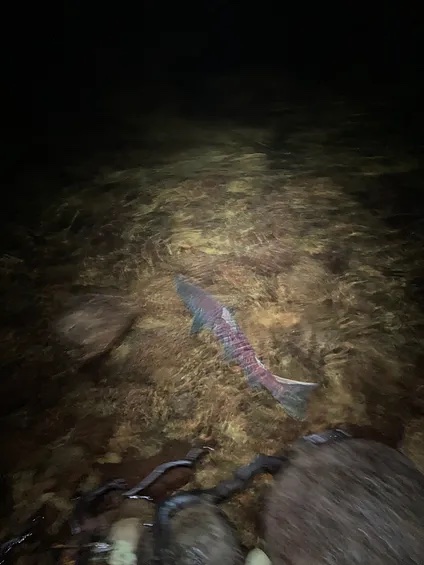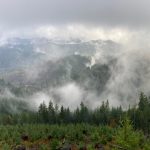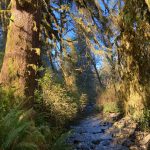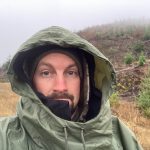The salmons are dying, all for the greed of humans. Salmons are only one of the numerous species at risk due to industrial civilization. We lose 200 species a day. This is an ecological crisis that we are facing. This is a call for action. Join a resistance. For all the species that we are losing every day. For the salmon. Align yourself with the natural world.
By Max Wilbert
Earlier this month I spent a week in the coastal mountains of Oregon, where industrial logging has replaced old-growth forests with monocrop plantations, released vast quantities of greenhouse gases, eviscerated biodiversity, and harmed rivers and streams via siltation and other forms of habitat destruction, water temperature increases, and chemical pollution.
On this trip, I camped a few feet from a salmon stream and was kept up by the sounds of Coho heading upstream to spawn — four fish. Just four.
- Industrial forestlands in the mist
- Healthy old-growth forest
- The author in an industrial clearcut
The rivers and streams of Washington, Oregon, and California are in crisis. Where salmon and steelhead have not already been driven extinct there are only small remnant populations holding on.
In the Western contiguous United States, four hundred and six salmonid populations have already been entirely destroyed, and one-third of remaining populations are listed under the endangered species act. Overall Pacific salmon numbers have declined by 98-99%.
The forests and rivers of the West need defenders. We have work to do. If salmon are going to survive, four things need to happen:
- Protect the forests. Industrial logging needs to stop.
- Protect the water. The dams must come down. Floodplains, wetlands, and estuaries must be restored and allowed to flourish. Toxic chemical pollution from stormwater runoff and forestry spraying must be stopped.
- Protect the fish. Commercial fishing must halt. Salmon farming must be stopped.
- Protect the cold. Global warming must be stabilized and reversed.





Counting on Biden to restore the environment is like hiring a nanny who only uses hard drugs “occasionally,” when she’s working — or limiting your teenage daughter’s dating to men with no forcible rape convictions.
We can’t count on Biden or any politician to save and restore the natural environment. Quite the contrary, we can count on them to destroy it and kill the life there. WE will have to fight for the Earth and the life here, because the Golgafrinchans who’ve taken over the planet don’t care about it.
The rivers and streams of Washington, Oregon, and California are in crisis. Where salmon and steelhead have not already been driven extinct there are only small remnant populations holding on.
In the Western contiguous United States, four hundred and six salmonid populations have already been entirely destroyed, and one-third of remaining populations are listed under the endangered species act. Overall Pacific salmon numbers have declined by 98-99%.
I agree with Max. There is no difference in reality between “private” land and “public” land; those are just artificial human constructs. Moreover, the entire concept of human ownership of land is not only the immoral equivalent to owning people, it’s also detached from reality. The indigenous people here had no concept of land ownership; that’s mental disease that was brought here from Europe. As a Native told me once, if anything the land owns YOU.
We need to fight for ALL land and ALL life, not just that on what the colonizers have deemed public land.
The Public Trust Doctrine is the 2,000 year-old legal standard that says certain environmental phenomena are so important to survival that they inherently belong to the public and cannot be alienated from the public. As such, the states hold navigable rivers, coastlines, and fisheries in the public trust and by definition, they cannot be sold to private interests.
There has been an expansion of what states are required to hold in trust for the public, and the 1983 Mono Lake case broadened the scope to include tributaries to navigable rivers. Hawaii has also broadened the scope and recently a suit was brought against Governor Brown arguing the atmosphere must be held in the public trust. The Oregon Supreme Court rejected the plaintiffs arguments, saying:
“We also decline, in this case, to adopt plaintiffs’ position that, under the public trust doctrine, the state has the same fiduciary duties that a trustee of a common-law private trust would have, such as a duty to prevent substantial impairment of trust resources.”
But, they also said:
“We hold that the public trust doctrine currently encompasses navigable waters and the submerged and submersible lands underlying those waters. Although the public trust is capable of expanding to include more natural resources, we do not extend the doctrine to encompass other natural resources at this time.”
In the Mono Lake case, the California Supreme Court said:
“The public trust is more than an affirmation of state power to use public property for public purposes. It is an affirmation of the duty of the state to protect the people’s common heritage of streams, lakes, marshlands and tidelands, surrendering that right of protection only in rare cases when the abandonment of that right is consistent with the purposes of the trust.”
Water League is based out of the Rogue Basin in southwest Oregon and works throughout the west to engage the public in Water stewardship and all that flows from Water. Visit http://www.waterleague.org for more information.
I worked 30 years for the BC Forest Service on Southern Vancouver Island. First in silviculture, later inspecting industrial logging operations, road building and road maintenance. Industrial logging of coastal rainforests has wiped out so many salmon streams but the Forest and Range Practices Act and it’s regulations are useless in stopping this damage. Part of my job was to investigate and prosecute landslides where the company failed to practice due diligence. I put countless hours into investigations but probably less than 10% resulted in some form of charge. The legislation was essentially written by industry. One areas I spent a lot of time in was the Klanawa River drainage. At one time this was a beautiful, diverse valley bottom forest. Large portions of the river floodplain were logged to the stream edge to supposedly salvage an outbreak of hemlock looper. The River had Chinook, Coho, Sockeye, Sea Run Cutthroat Trout and Steelhead Trout. The numbers are down well over 90% now. Industry is now logging the higher slopes in this drainage and the roads built and poorly maintained on steep slopes routinely have landslides. The regenerated second growth forests are now being logged when they are barely 50-60 years old. I could provide hundreds of other examples.and yet all industry can show is photos of their regenerated second growth forests as if their industry was sustainable. Buffers of trees left along streams generally blow down after a few storms and rarely work to protect streams, in fact often erode the banks of smaller, steeper streams that feed into the larger rivers causing sedimentation. Many of the main log hauling roads were built adjacent to rivers that at one time had huge salmon runs. The only thing that has kept salmon populations up here are hatcheries. This has dramatically reduced the gene pool. Many streams turn chocolate brown during and after rain events, In 2020 I flew over Nitinat Lake, a tidal lake connected to the Pacific Ocean through a tidal channel. The lake was completely brown in color after a large rain event and a large plume of sediment was washing into the ocean. After 30 years of trying to do something positive in my work I realized it was pointless and retired. The morale of many of my co workers still working is pretty low and people are giving up. The only forestry laws that stick are for timber theft and cheating on stumpage calculations. The environmental laws are basically smoke and mirrors.